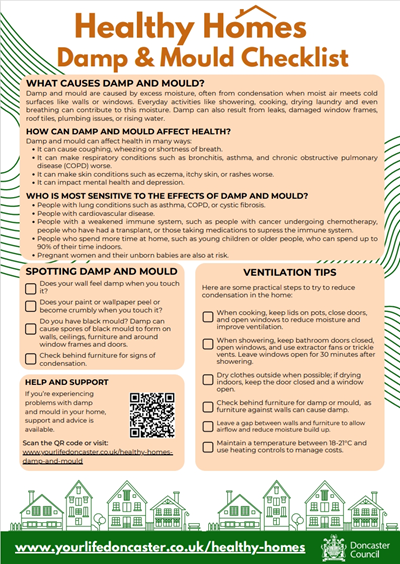Healthy Homes: Damp and Mould
.png)
Damp and Mould can be caused by excess moisture. Nearly all damp in homes is caused by condensation, this is when moisture in the air comes into contact with a cold surface, such as a wall, window, or mirror. Most moisture in the home is caused by things such as showering, cooking, drying laundry and even breathing. This can then lead to mould growth on walls, ceilings, and furniture. Damp may also be caused by internal leaks through things like damage to window frames or missing roof tiles, plumbing problems, or water rising from the ground. To find out more on spotting the signs and how to combat, visit the council website.
Damp and mould checklist
- Damp and Mould checklist
- Download (166KB - PDF)
How might this impact health?
Damp and Mould can affect health in many ways:
- It can cause coughing, wheezing or shortness of breath.
- It can make respiratory conditions such as bronchitis, asthma, and chronic obstructive pulmonary disease (COPD) worse.
- It can make skin conditions such as eczema, itchy skin, or rashes worse.
- It can impact mental health and depression.
Certain groups are more vulnerable to the effects of damp and mould, particularly:
- People with lung conditions such as asthma, COPD, or cystic fibrosis.
- People with cardiovascular disease.
- People with a weakened immune system, such as people with cancer undergoing chemotherapy, people who have had a transplant, or those taking medications to supress the immune system.
- People who spend more time at home, such as young children or older people, who can spend up to 90% of their time indoors.
- Pregnant women and their unborn babies are also at risk.
What steps can be taken?
Try to ventilate and heat the home adequately. We know that due to the cost of living, heating the home can be difficult. Even when a property is being ventilated and heated, damp and mould can still happen. Here are some practical steps to try to reduce condensation in the home:
- When cooking, try to keep lids on pots and pans, close doors, and open windows to help ventilate the home and reduce moisture.
- When showering, keep bathroom doors closed, try to open windows, and use extractor fans or trickle vents if possible. Ideally windows should be left open for at least half an hour after showering.
- Dry clothes outside wherever possible. When drying clothes in a room, leave the door closed and a window open.
- If possible, always keep the temperature between 18-21 degrees. Heating controls on radiators, room thermostats and timers will help control and manage home heating costs.
- Leave a gap between external walls and furniture to help with air flow. Furniture that is pushed up to a wall, such as wardrobes or sofas, can trap air and create excess moisture.
What support is available?
If you rent your home try to speak to the landlord and report any issues, it is their responsibility to find out what is causing the damp and deal with it quickly.
- For information about repairs in private rented homes and how to report an issue, please visit our repairs page. For further support please visit Citizens Advice.
- If you feel that the landlord has been unable, or is unwilling to put it right, you can contact the Council’s Housing Enforcement Team for advice. They may be able to assist and inspect to determine if there is action that can be taken: visit Private Rented Accommodation Repair Problems Form - City of Doncaster Council or call 01302 737573.
- If your home is a St Leger Homes property, further information and advice is available, please visit the St Leger Homes website If issues are unable to be resolved, please call the Customer Access Team on 01302 862862.
- For energy saving advice and information on grants visit the Doncaster Council website or visit our cost of living webhub.
- If you are a private landlord, property manager, managing agent, or owner of an empty property, and are looking for help and guidance, you can find information through the council website or contact LandlordHelpAndAdvice@doncaster.gov.uk
- Use our helpful checklist for spotting the signs and ventilation tips to take in the home Damp and Mould checklist

